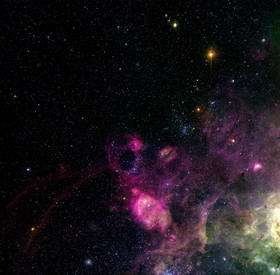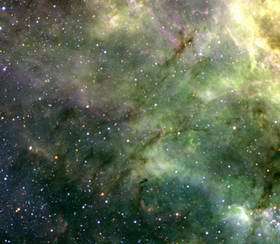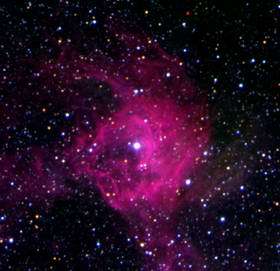Turbulent and Colourful LMC Region Imaged from La Silla

The Tarantula Nebula is one of the most impressive views in the Southern sky. Visible to the unaided eye in the Large Magellanic Cloud (LMC), a satellite galaxy of the Milky Way that is located in the direction of the southern constellation Doradus at a distance of about 170,000 light-years, this huge nebula is the prototype of what astronomers refer to as a "Giant HII region". In this complex of glowing gas and very hot and luminous stars, the gas is mainly composed of protons and electrons, which are kept apart by energetic photons emitted by the stars in this area.
The Tarantula Nebula (also designated 30 Doradus) owes its name to the arrangement of its brightest patches of nebulosity that somewhat resemble the legs of a spider. They extend from a central "body" where a cluster of hot stars (designated "R136") resides that illuminate the nebula. This name, of the biggest spiders on the Earth, is also very fitting in view of the gigantic proportions of the celestial nebula - it measures nearly 1,000 light years across!
While the central regions of 30 Doradus may be compared to a tarantula, the entangled filaments in the outskirts of this nebula could well be likened with its cobweb. They testify to an ongoing history of very vigorous activity and make this spectacular sky region a showcase of dramatic effects caused by the tremendous output of energy from the most massive stars known.

Intricate colours
The marvellous richness of the filament colours is due to the varying conditions in the interstellar gas in this region. The red in these images is caused by emission of excited hydrogen atoms, the green shades correspond to emission from oxygen atoms from which two electrons ("doubly-ionized oxygen") have been "knocked off" by the energetic radiation of hot stars in the R136 cluster, that is located beyond the lower right corner of this photo. The intensity of this emission increases towards R136, explaining the yellowish colour near the edge of the photo.
A blue colour is contributed by singly-ionized atoms of oxygen. Other atoms like nitrogen and sulfur at different levels of ionization also add to the emission of the nebula at specific wavelengths. The observed colours thus probe the physical condition of the emitting gas and the temperature of the star(s) that excite(s) it. The intricate appearance of the filaments is mostly a consequence of turbulence in the interstellar gas, of the magnetic fields, and of the energy input by the massive stars in the neighbourhood.

Supernovae blow interstellar "bubbles"
The large ring-shaped nebula slightly to the lower-left (South-East) of the centre of the top image is known as DEM L 299. Detailed investigations show that it represents an "interstellar bubble" which was "blown" by supernovae explosions, most probably happening millions of years ago, as massive stars near the centre of this structure ended their comparatively short lives in glorious flashes.
A closer inspection shows that another supernova exploded somewhat later near the rim, forming a bright and more compact nebula known as SNR 0543-689. Other supernovae in this general field exploded even more recently, such as the one that created the remnant B0544-6910 only a few tens of thousands of years ago, a blink of an eye by all astronomical standards.
Nebulae with built-in powerhouses
Not all the nebulae seen in this region are caused by supernovae, however. The glow of N 164, a bright, extended red-yellow nebula just below DEM L 299, is mostly due to its own "private" powerhouse, that consists of several massive stars deeply embedded in its interior.
The same holds for DEM L 297, the somewhat smaller and fainter nebula to the right of DEM L 299. It is divided into two half-circle formed segments by a dark lane of interstellar dust in front of it. Indeed, within the Tarantula complex many such dark and dusty clouds are seen in silhouette as they obscure bright nebulosity behind them.
Many stellar clusters
The outskirts of the Tarantula Nebula are also rich in stellar clusters. One of them, NGC 2093 [1], has relatively few stars and is relatively young, just a few tens of millions of years. It appears that its stars have already excavated a sizeable cavity around them that is now relatively void of gas.
An older and much more compact cluster, NGC 2108. It resembles the globular clusters in our own Galaxy, but it formed much more recently, about 600 million years ago. Still, NGC 2108 is much older than the Tarantula complex and it is quite possible that in its "youth" it was the core of another giant HII region that has since dissolved into interstellar space.
Source: ESO















